Quick Summary: Learn how to integrate AI into an app for mobile and web platforms with confidence. This guide helps business leaders plan, build, and scale AI features that improve efficiency and performance. It explains real challenges, practical steps, and proven strategies from successful implementations. Discover how data, expert development, and structured planning can turn your app into an intelligent solution that drives measurable business growth.
Integrate AI into an app to make every business decision sharper, faster, and more accurate. Many brands plan to adopt AI but feel stuck between unclear goals, technical doubts, and unreliable development options.
That hesitation is costing opportunities every single day. Across industries, companies investing in AI-powered apps are already seeing measurable returns.
Analysts project the AI apps market to grow from USD 2,940 million in 2024 to USD 26,362.4 million by 2030, at a CAGR of 38.7% between 2025 and 2030. (Source: Grandview Research)
These numbers reflect trust and confidence from global enterprises that treat AI as a core growth driver.
AI brings automation, prediction, and personalization together to help businesses scale faster. Staying updated with AI trends allows companies to adopt technologies that truly make an impact.
This guide explains how to integrate AI into an app, avoid costly mistakes, and find a development partner who delivers measurable results.

What Does It Mean to Integrate AI into an App?
To integrate AI into an app means adding intelligent technology that studies data, learns behavior, and predicts outcomes. It allows software to make decisions, automate processes, and deliver accurate results without needing constant manual inputs or fixed human rules.
When companies integrate AI into an app, the software starts recognizing behavior patterns. The AI system studies user activity, learns preferences, and adjusts responses in real time. This learning approach helps businesses deliver faster and more accurate services.
AI integration links trained models within the app’s backend. Each model processes data such as images, voice, or user actions. These models generate insights, predictions, and suggestions that directly improve app performance. Travel apps plan routes automatically. Finance apps identify fraud before transactions finish.
Businesses integrate AI into an app in two ways. Some companies create custom AI models using internal business data, while others connect APIs or ready-to-use tools from trusted providers such as Google or OpenAI. Each approach aligns with different AI use cases, company size, budget, and privacy requirements.
AI integration in existing apps improves speed, accuracy, and user satisfaction. It also reduces manual errors and enhances decision-making quality. Companies that begin early strengthen business systems and gain a lasting competitive advantage.
How Businesses Can Integrate AI into an App Without Technical Confusion
To Integrate AI into an App successfully, begin with a clear business goal, prepare quality data, select suitable technology, integrate models into workflows, test performance, and monitor results.
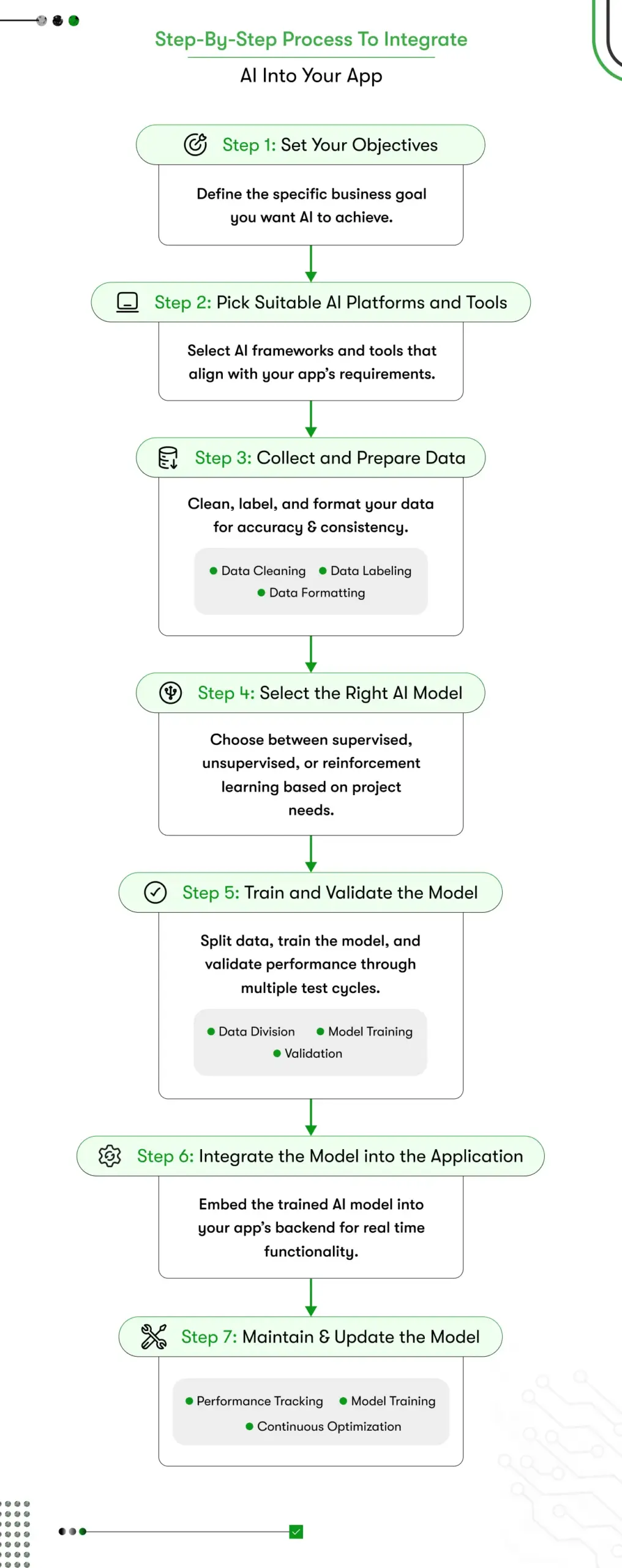
These practical steps ensure dependable and scalable AI integration in existing app systems.
Step 1: Identify Measurable Business Problems
Start with a specific goal that AI can improve. Many teams rush into development without defining measurable outcomes. Instead, choose one high-impact area such as improving customer response time, predicting sales, or reducing process delays.
Learn from this:
- Focus on one problem that influences measurable revenue or cost improvement.
- Define success metrics before starting to Integrate AI into an App.
- Avoid vague goals like “adding AI features” without business alignment.
Step 2: Assess Your App’s Technical Readiness
Before integrating AI into an app, evaluate how well your current systems handle data and automation. Reviewing the app’s backend architecture, API setup, and database design also helps identify new AI business ideas that can improve operations. A technical readiness check ensures the infrastructure can support AI without affecting speed or reliability.
Checklist for readiness:
- Confirm all APIs are well-documented and accessible for AI integration.
- Validate that your database can handle large and real-time data processing.
- Ensure security permissions align with data sharing across modules.
Step 3: Prepare and Centralize Reliable Data
AI models depend on accurate data. Collect information from your CRM, ERP, or customer service systems and combine it in one location. Clean duplicates, remove incomplete entries, and label patterns clearly. A structured dataset strengthens prediction accuracy and reduces training errors.
Pro tip:
- Create a single, verified data warehouse that serves as the foundation for every model.
- Use automated data cleaning tools to improve accuracy and reduce human errors.
- Regularly audit stored data to maintain its relevance and freshness.
Step 4: Choose the Right AI Technology and Tools
To Integrate AI into an App effectively, choose technology that matches your business capacity. Custom AI models are ideal for enterprises with rich data and unique workflows. Smaller teams can use APIs from providers like OpenAI, Google Cloud, or AWS to achieve faster deployment.
Practical insight:
- Assess your team’s technical skill before finalizing any AI framework.
- Always calculate total ownership cost, including maintenance and retraining.
- Select tools that easily scale with future AI integration in existing app systems.
Step 5: Gather and Prepare Information for Training
Once tools are selected, collect relevant training data and prepare it for model development. Clean, label, and categorize datasets so they represent real business situations. Strong data preparation ensures better model accuracy and relevance.
Implementation focus:
- Label and classify data based on the problem you aim to solve.
- Balance datasets to prevent biased predictions.
- Store all raw and processed data for retraining cycles.
Step 6: Integrate the Model with Your App Backend
Developers connect the trained AI model to the app’s backend so it can analyze real-time data and generate insights. This connection allows predictions, alerts, or recommendations to reach users instantly within the app interface. Smooth backend integration ensures consistent app performance.
Implementation advice:
- Use RESTful APIs to keep model integration flexible and secure.
- Test API responses under different loads to prevent downtime.
- Maintain version control for each model release to track performance changes.
Step 7: Select and Train the AI Model
Select the model that best fits your business need, such as supervised learning for predictions, unsupervised learning for clustering, or reinforcement learning for adaptive decision-making. Train the model using prepared data and validate it for performance.
Smart approach:
- Split data into training, testing, and validation sets.
- Track metrics like accuracy, precision, and recall.
- Refine hyperparameters until consistent results are achieved.
Step 8: Monitor, Retrain, and Improve Performance
Once deployed, AI models need continuous supervision. Monitor performance metrics weekly. Retrain models with new datasets as trends evolve. Regular improvements prevent performance drops and ensure long-term accuracy in business operations.
Best practices:
- Set automated alerts for accuracy thresholds and anomalies.
- Retrain models every quarter or whenever performance dips below target.
- Document all model updates for transparency and compliance.
Step 9: Scale Gradually Across Business Functions
After achieving consistent results, expand your AI scope carefully. Start by extending features to related workflows such as marketing, logistics, or finance. Each expansion should focus on improving measurable KPIs like conversion rate, delivery accuracy, or cost efficiency.
Growth recommendations:
- Add one department at a time to maintain control and stability.
- Evaluate ROI after every integration stage to justify further investment.
- Continue aligning AI strategies with overall business objectives.
Step 10: Maintain and Optimize Models Continuously
AI app integration continues beyond deployment. Regular maintenance keeps models accurate, responsive, and aligned with real-world data. Businesses must treat this stage as ongoing development rather than a one-time task.
Performance can drift over time as user behavior or market conditions change. To maintain reliability, retrain models with new datasets, update frameworks, and monitor performance logs closely. These activities prevent accuracy loss and keep the system scalable.
Maintenance priorities:
- Track model performance metrics monthly and document every change.
- Refresh datasets regularly to reflect new user and market patterns.
- Update AI tools, frameworks, and libraries to maintain security and compatibility.
- Review integration logs to identify latency or prediction issues early.
- Evaluate business outcomes every quarter to confirm consistent ROI.
Successful AI adoption depends on clear goals and expert execution. Businesses that start structured AI projects see faster growth, smarter automation, and consistent returns. With deep expertise in AI app development, Kody Technolab Limited helps enterprises achieve these outcomes through tailored AI integration in existing app systems designed for measurable business success.
Common Challenges in AI Integration and How to Overcome Them
Many businesses face difficulties while trying to Integrate AI into an App. The main challenges include poor data quality, complex system architecture, limited AI skills, and unclear goals. Careful preparation, expert guidance, and continuous monitoring help avoid costly integration mistakes.
1. Lack of Clear AI Strategy
Many companies start Integrating AI into an App without a clear strategy. They want results but cannot define what success looks like. The project loses focus and often ends with high costs and low returns.
How to fix it:
Start by defining a clear objective such as improving customer experience, reducing manual workload, or predicting demand. Outline measurable KPIs before development begins. When the goal is clear, every technical step becomes easier to execute and measure.
2. Weak or Unorganized Data
AI performance depends on data. Poor-quality data confuses models and produces unreliable outcomes. Missing values, duplicated entries, or inconsistent formats are common reasons for failed AI integration in existing app systems.
How to fix it:
Conduct a complete data audit before training any model. Clean, label, and validate datasets carefully. Build a unified data pipeline that collects information from every source. Reliable data helps AI recognize patterns and generate accurate predictions for users.
3. Complex Legacy Infrastructure
Businesses that run on outdated systems often face technical hurdles while trying to integrate AI into an app. Old frameworks and slow APIs block communication between the generative AI solution and the app’s backend, limiting performance and scalability.
How to fix it:
Modernize critical parts of your infrastructure before integration begins. Upgrade APIs, optimize databases, and test load capacity. Partnering with experienced developers ensures AI connects smoothly without breaking existing workflows.
4. Shortage of Skilled Professionals
Building and managing AI systems require both technical and analytical expertise. Many internal teams understand coding but not machine learning, model validation, or data handling. This skill gap increases development time and risk.
How to fix it:
Collaborate with a trusted AI development services provider. Choose experts who understand both software engineering and data science. Continuous knowledge sharing between business and development teams keeps the integration aligned with real goals.
5. High Maintenance and Model Decay
Once deployed, AI models lose accuracy as market trends and user behavior change. Without updates, predictions become outdated and unreliable. Ignoring this issue damages user trust and business results.
How to fix it:
Monitor model performance regularly. Retrain AI models using recent data every few months. Automate accuracy tracking through dashboards that send alerts when performance drops. Consistent maintenance keeps AI reliable and ready for evolving business needs.
6. Security and Compliance Risks
AI systems handle sensitive information, which increases the risk of data leaks or misuse. Businesses often underestimate security measures when Integrating AI into an App. Even a small breach can lead to compliance penalties or customer loss.
How to fix it:
Encrypt all data before storage or transfer. Follow global data standards such as GDPR or HIPAA based on your industry. Regular audits and vulnerability tests prevent unauthorized access and ensure legal compliance.
Overcoming challenges in AI integration requires more than technology. Effective integration demands clarity of purpose, reliable data pipelines, and consistent monitoring. Using trusted AI development platforms helps teams manage these tasks efficiently. When businesses treat AI as a long-term capability instead of a one-time feature, every app upgrade becomes smarter and more sustainable.
What the Future Holds for Businesses That Integrate AI into an App
The future of AI integration in existing app systems focuses on real-time decision-making, automation, and personalized experiences. Businesses that start Integrating AI into an App today will gain smarter insights, faster scalability, and stronger customer connections in the years ahead.
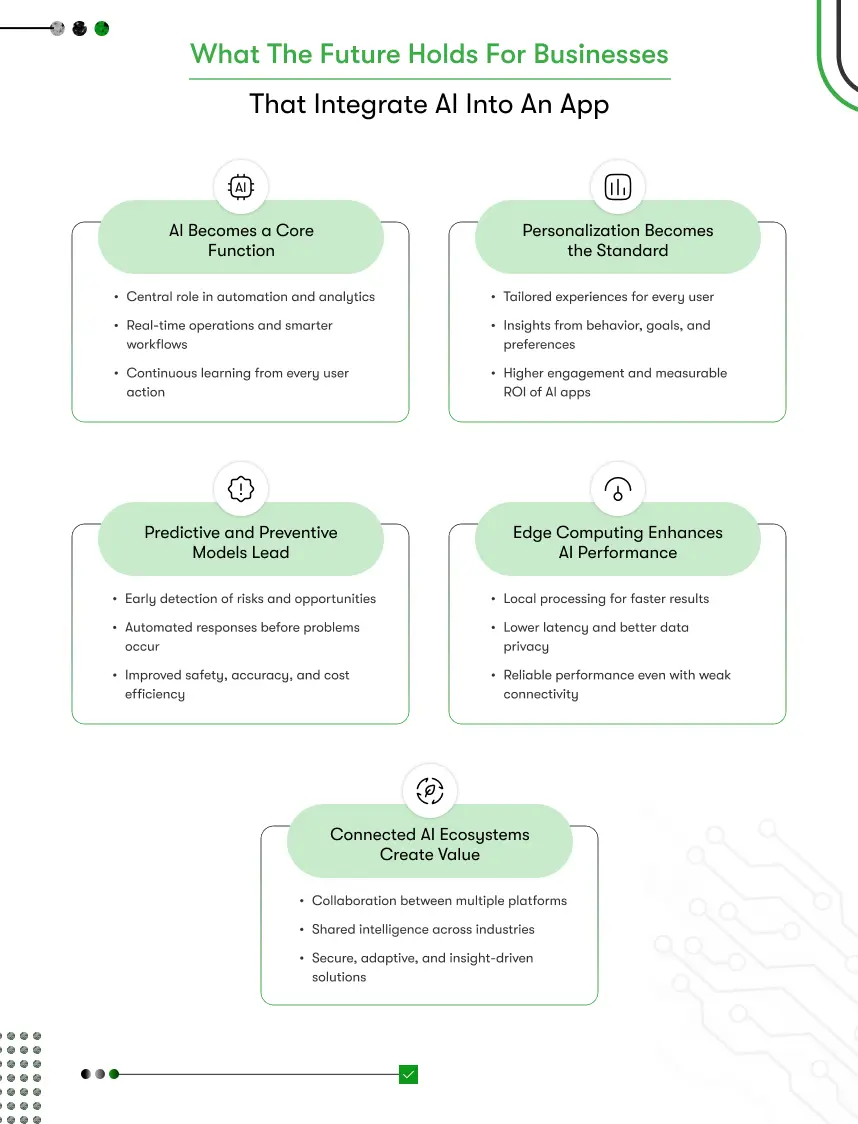
AI Becomes a Core Function, Not an Add-On
AI app integration now sits at the center of modern software design. In current systems, intelligence supports every key function and user action. Businesses that Integrate AI into an App gain unified control over automation, analytics, and personalization.
Mobile and web apps built with AI operate in real time. Each user interaction improves predictions and keeps results accurate. This approach creates applications that stay relevant, responsive, and aligned with business goals.
Personalization Becomes the Standard
AI integration in existing app environments allows companies to deliver tailored experiences at every touchpoint. Apps study user preferences, habits, and goals to make accurate recommendations. Understanding the ROI of AI apps helps businesses measure how personalization directly increases engagement and revenue.
For instance, a healthcare app might adjust nutrition plans based on medical history, while a retail app could recommend outfits that match past purchases and weather conditions. Businesses that focus on integrating AI into an app for personalization build stronger customer loyalty and long-term value.
Predictive and Preventive Models Gain Priority
AI now supports early action instead of late correction. Predictive systems detect risks or needs before they occur.
In logistics, predictive AI can identify potential delivery delays and suggest better routes. In finance, automated systems can spot unusual transactions before damage occurs. These capabilities save time, reduce costs, and improve operational safety.
Edge Computing Enhances AI Performance
Running AI locally inside the app, rather than depending on external servers, makes systems faster and safer. Edge-based AI reduces latency, protects sensitive data, and works smoothly even with limited connectivity.
Businesses that Integrate AI into an App using edge technology gain higher speed, better reliability, and improved compliance. This approach ensures consistent user experience under all network conditions.
Connected AI Ecosystems Create New Value
The next phase of AI app integration will focus on collaboration between platforms. Apps across industries will share intelligence securely to enhance performance and insights.
For example, a travel app could connect with weather data, hotel bookings, and maps to deliver complete trip guidance. Each AI system will contribute to shared learning while maintaining data security. This collaboration will create more powerful and adaptive solutions.
The future of AI integration in existing app systems revolves around automation, accuracy, and personalization. Businesses that plan early and Integrate AI into an App with structured goals will achieve faster growth, smarter operations, and stronger market differentiation.
AI integration changes how businesses operate and deliver outcomes. Companies that focus on structured and secure AI app integration today achieve measurable growth, faster decisions, and consistent improvement in customer experience.

Real-World Examples of AI App Integration That Prove What’s Possible
Businesses across industries use AI app integration to improve performance and customer service. These verified examples show how global organizations Integrate AI into an App to automate processes, make accurate predictions, and create measurable business results.
1. PwC and National Health System for Patient Engagement
PwC helped a nonprofit health network improve patient support through conversational AI. The solution was integrated within Salesforce Health Cloud and automated routine patient queries, appointment scheduling, and record updates.
The project saved more than 3,000 staff hours each month and lowered call abandonment rates by 85 percent. This example of integrating AI into an app demonstrates how healthcare systems can improve access and reduce workloads using automation within existing tools.
2. Finshape Mobile Banking Chatbot
Finshape partnered with UXStudio to build a generative AI chatbot directly into its banking application. The chatbot answers queries, tracks spending, and creates personalized reports within seconds. Companies planning to build AI chatbots app for similar use cases can see how such tools transform customer engagement.
This example of AI integration in existing app systems shows how banks enhance user experience and trust while maintaining secure operations. Financial institutions that integrate AI into an app achieve faster response times and deeper client relationships.
3. Amazon Go Retail Application
Amazon Go uses computer vision, predictive models, and sensors to power its checkout-free retail app. The system identifies products taken by customers and processes billing automatically through the connected mobile app.
In addition, data from cameras and sensors guides layout changes that increase sales and improve traffic flow. This real example of AI app integration shows how retail companies can combine analytics and automation to deliver convenience and profitability.
4. Takeda Pharmaceuticals Salesforce Integration
Takeda Pharmaceuticals integrated AI tools within its Salesforce environment to automate proposal evaluation. The system reviews incoming documents, identifies key criteria, and prepares summary reports for managers.
This practical case of AI integration in existing app platforms shows how automation improves speed, accuracy, and decision consistency within complex enterprise systems.
Lessons for Businesses from Real AI App Integrations
The success stories above highlight clear lessons for companies planning to Integrate AI into an App. Each project shows what made AI adoption effective and scalable in real business conditions.
Define measurable business goals before development.
Every successful case began with a defined target, such as improving patient response time or automating customer service. Clear objectives give direction and prevent wasted effort during AI app integration.
Build a strong and clean data foundation.
Accurate, unified data allowed these companies to train models effectively. AI integration in existing app systems performs best when data is structured, verified, and continuously updated.
Maintain AI systems through constant improvement.
The companies that gained lasting results kept refining their models. Regular retraining, monitoring, and updates ensured that the integrated AI stayed accurate and useful for end users.
Choose reliable technical and strategic partners.
Each example involved experienced teams that aligned business goals with technology. Partnering with experts helps reduce errors, lower cost, and maintain long-term reliability.
When these lessons guide planning, businesses achieve sustainable outcomes from AI app integration while improving efficiency, customer experience, and decision accuracy.
Real results begin when AI serves a direct business purpose. Whether improving patient care or financial planning, companies that Integrate AI into an App gain long-term efficiency and insight. The examples above prove that structured integration builds stronger products and measurable outcomes.
Every business can learn from these success stories. Strategic, data-driven AI integration in existing app systems creates reliable solutions that scale with demand and drive continuous value. Understanding the AI app development cost also helps companies plan investments wisely and achieve better long-term returns.
How to Find the Right Partner to Implement AI in Mobile and Web Apps
The success of AI integration in existing app systems depends on the partner’s expertise and clarity. A capable team aligns technology, security, and business goals to deliver reliable AI app integration across mobile and web platforms.
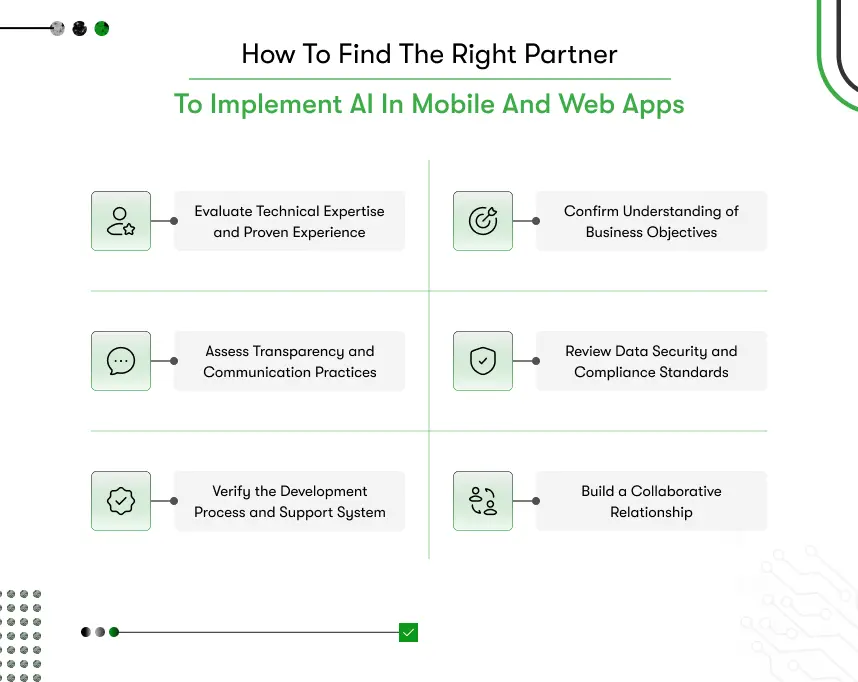
1. Evaluate Technical Expertise and Proven Experience
An effective partner must have deep experience with machine learning, cloud platforms, and app architecture. Review their previous AI implementations, technical stack, and measurable outcomes. Partners who have delivered large-scale AI app integration projects can manage complexity with precision and speed.
Study their portfolio and case studies. Focus on implementations involving predictive analytics, automation, or personalization. Verified experience ensures they can Integrate AI into an App without disrupting existing systems or performance.
2. Confirm Understanding of Business Objectives
Technical capability only creates value when aligned with the real goal. A reliable team begins by understanding what your business wants to achieve. This could include improving customer retention, automating workflows, or supporting data-driven decision-making.
Ask how every AI feature supports measurable outcomes. Alignment between business needs and technical execution ensures that every function contributes to performance and customer satisfaction during AI integration in existing app systems.
3. Assess Transparency and Communication Practices
Every stage of AI implementation requires clarity. Frequent updates, progress tracking, and detailed documentation prevent confusion and delay. Reliable partners communicate consistently and explain technical progress in simple terms.
Transparent reporting builds trust and accountability. When information flows smoothly, Integrating AI into an App becomes organized and predictable from development to deployment.
4. Review Data Security and Compliance Standards
AI projects often involve sensitive user and operational data. A responsible partner follows strict data protection measures, encryption practices, and compliance guidelines.
Ask about security frameworks, audit trails, and access control systems. Industries such as finance and healthcare demand adherence to standards like GDPR or HIPAA. Partners who maintain compliance deliver safer and legally sound AI app integration.
5. Verify the Development Process and Support System
AI implementation doesn’t end after launch. Models require ongoing monitoring, retraining, and improvement. A dependable team provides continued technical support, periodic updates, and optimization schedules.
Review their delivery workflow, post-launch support structure, and scalability options. Long-term assistance helps your company Integrate AI into an App sustainably while adapting to new data and market trends.
6. Build a Collaborative Relationship
Successful AI integration thrives on collaboration, not outsourcing. Look for partners who work as part of your internal team. They should involve your staff in planning, decision-making, and testing to maintain shared ownership of outcomes.
When collaboration drives progress, every AI initiative aligns naturally with business strategy. This partnership mindset ensures meaningful and lasting success.
Selecting the right partner for AI implementation requires evaluating expertise, transparency, and collaboration. Businesses that plan to hire AI developers should focus on teams with proven technical and strategic skills. When both sides align on purpose and execution, AI integration in existing app systems delivers measurable impact and consistent business value.
Strong partnerships turn AI adoption from theory into tangible growth. With the right collaboration, AI app integration becomes efficient, secure, and scalable for every business model.
Conclusion: Turning AI Integration into Real Business Growth
Businesses that decide to Integrate AI into an App take a strong step toward smarter, faster operations. AI improves accuracy, automates decisions, and unlocks new insights that guide better growth. Clear planning and the right strategy make these results achievable.
Industries such as healthcare, finance, logistics, and retail have already gained measurable value through AI integration in existing app systems. Each success story proves that technology, when implemented thoughtfully, can deliver lasting impact.
Kody Technolab Limited helps organizations worldwide build reliable AI-driven software for real outcomes. As a trusted generative AI development company, Kody designs intelligent applications that simplify processes and create consistent business results.
If your company is ready for AI app integration, contact our experts today to plan your next intelligent solution with confidence.

Frequently Asked Questions (FAQs)
1. How do I know if my business is ready to Integrate AI into an App?
You are ready when your app collects consistent data, has clear goals, and stable infrastructure. Conduct a quick system audit to confirm data quality and scalability before AI integration begins.
2. How much does AI integration in existing app systems usually cost?
Costs depend on complexity, data needs, and model type. A basic AI feature can start from $10,000, while enterprise-grade integrations can reach $150,000 or more. Custom evaluation ensures accurate budgeting.
3. How long does it take to complete AI app integration?
A simple integration may take 6 to 8 weeks. Complex projects that involve multiple models, automation, or predictive systems can take 3 to 6 months depending on data preparation and testing cycles.
4. What kind of data is needed for Integrating AI into an App?
AI learns from structured, high-quality data. Transaction records, customer behavior logs, and operational analytics form the foundation. Better data improves model accuracy and app performance.
5. Can AI be integrated into both web and mobile apps?
Yes. AI integration in existing app environments works across web, mobile, and cloud-based systems. The architecture and model deployment plan decide how well the AI adapts to each platform.
6. What are the biggest challenges during AI app integration?
Data quality issues, unclear goals, and lack of skilled developers cause most failures. Reliable partners fix these challenges with better planning, clean data, and transparent execution.
7. Why should I partner with Kody Technolab to Integrate AI into an App?
Kody Technolab Limited helps companies Integrate AI into an App using a structured and transparent process. The team focuses on real business results, ensuring faster deployment, better scalability, and reliable performance. Each solution is tailored to support your goals and enhance customer experience across mobile and web platforms.

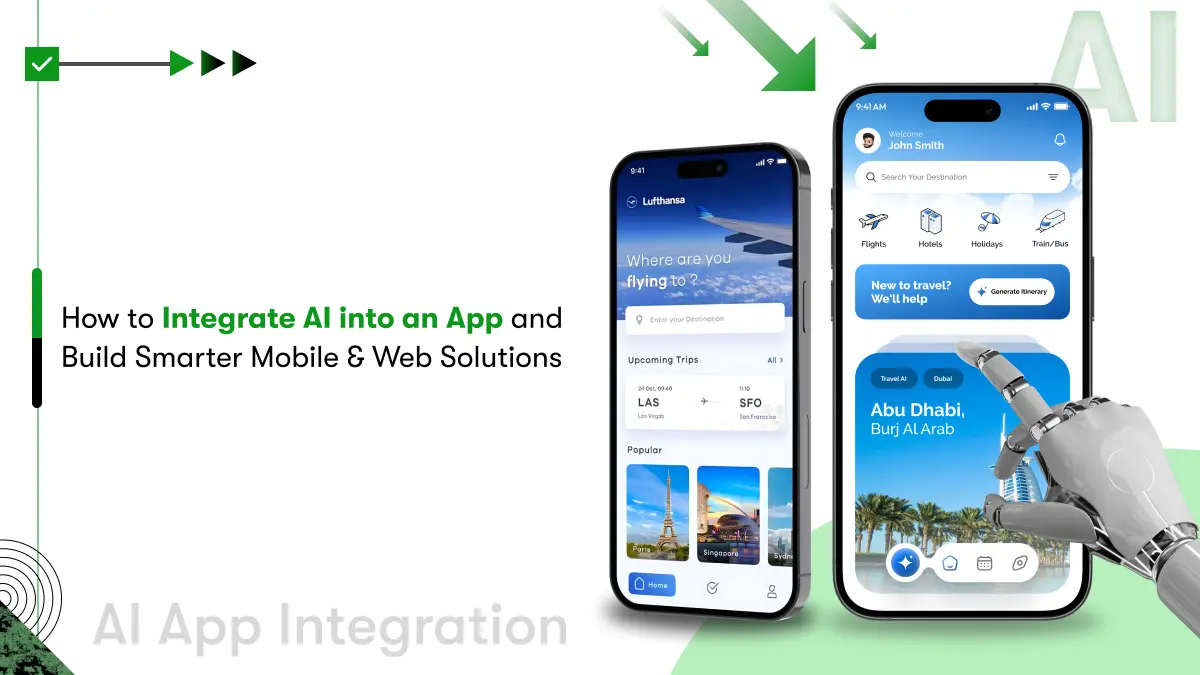
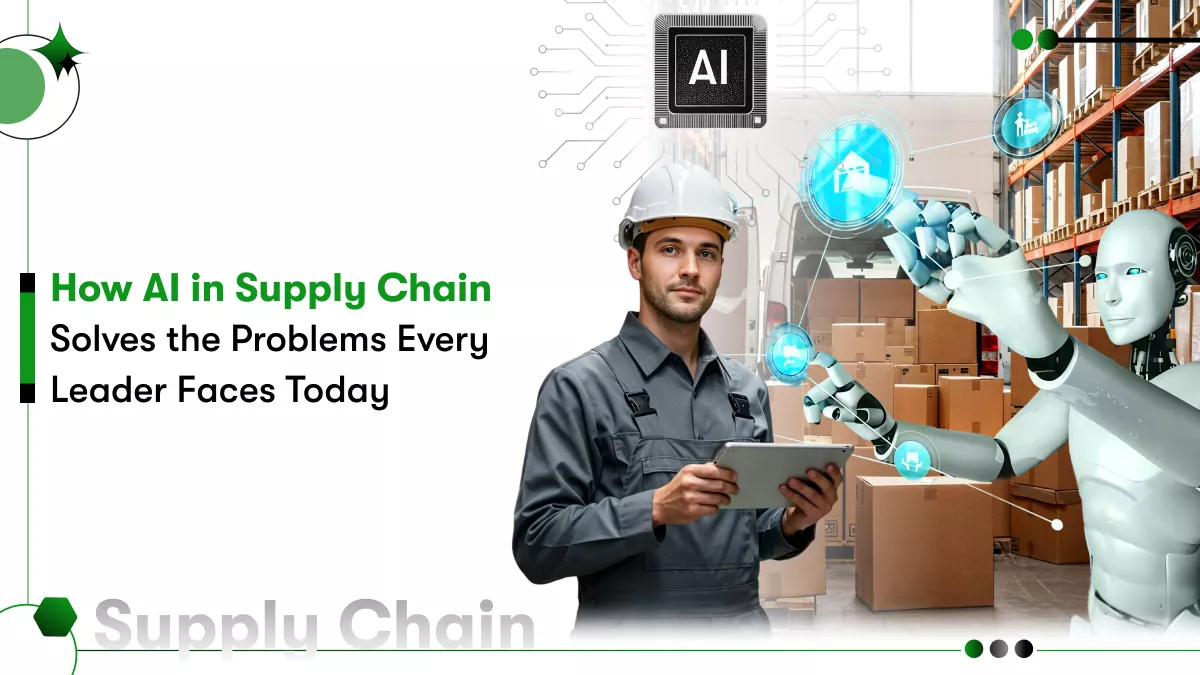

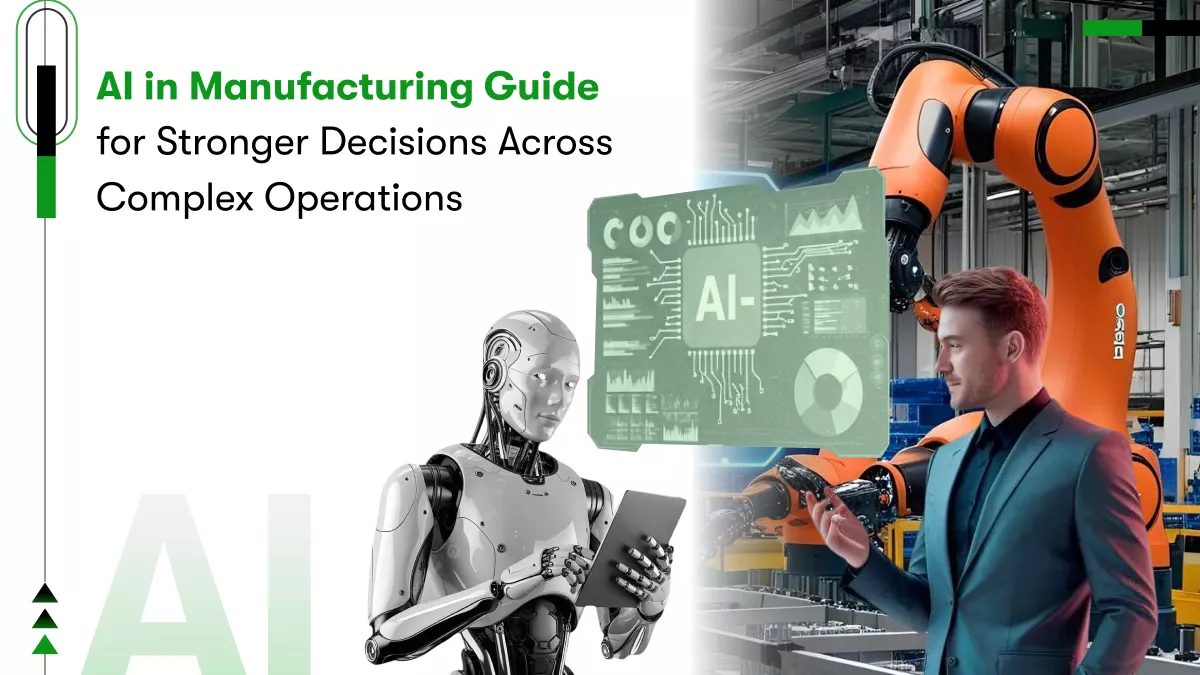
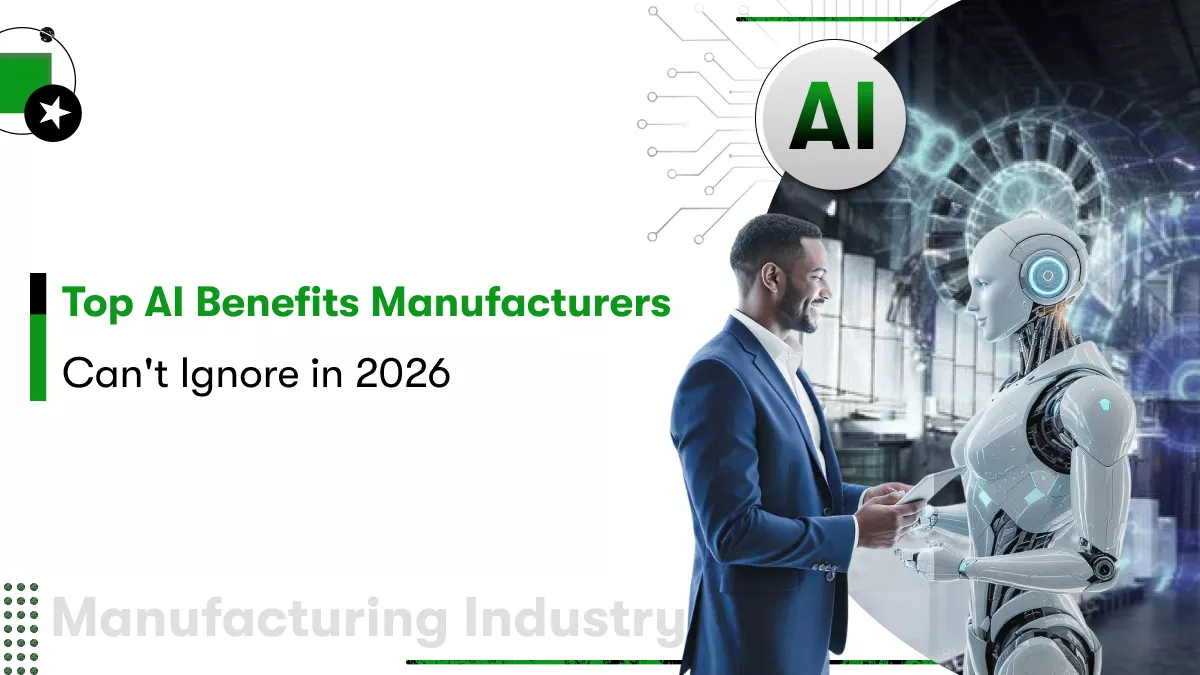
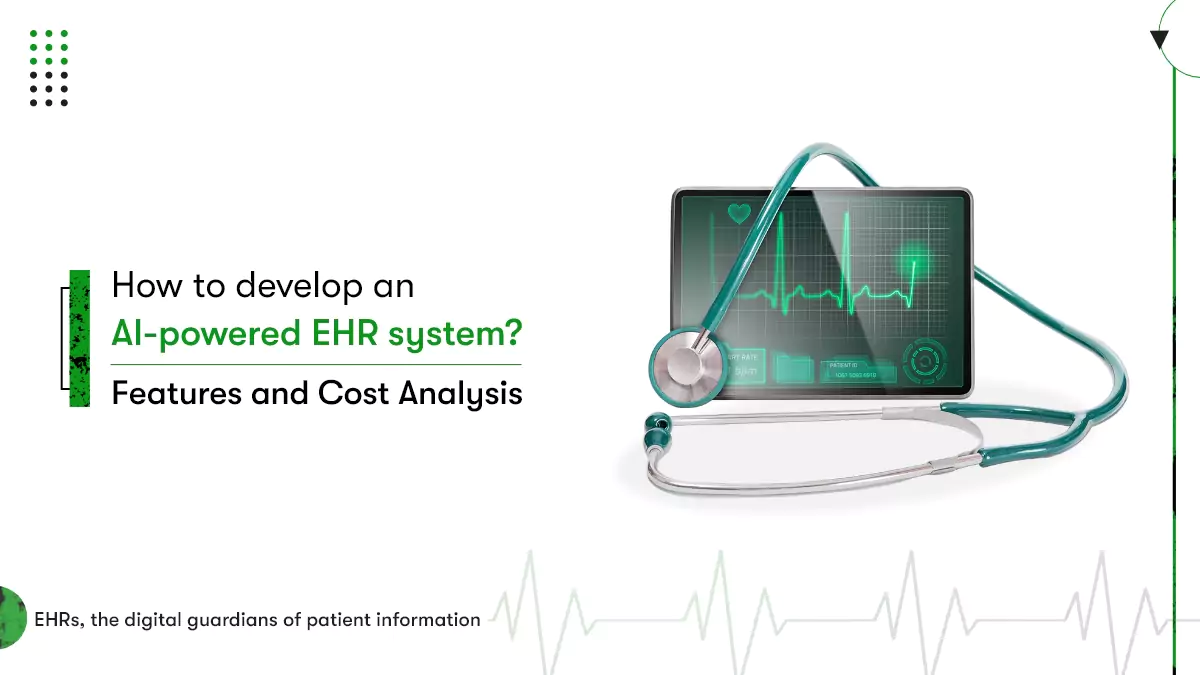






 Contact Information
Contact Information